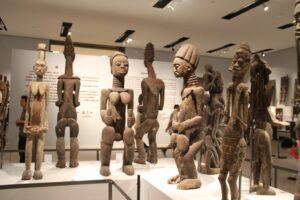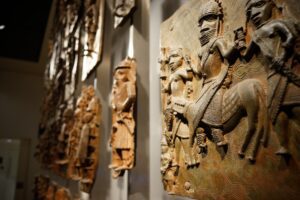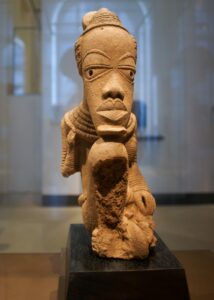Historical African art is a profound expression of the continent’s rich cultural heritage, encapsulating millennia of tradition, spirituality, and social dynamics.
It’s a diverse collection of creative works that range from majestic sculptures to intricate textiles, each piece telling a unique story of the people and eras that crafted them.
We’ll jump into the significance and various forms of African art, exploring how these historical treasures continue to influence the world today.
Join us as we uncover the vibrant legacy of African artistry that has captivated historians and art lovers alike for generations.
The Significance Of Historical African Art
Historical African art isn’t merely a reflection of aesthetic values from bygone eras; it’s a potent testament to the continent’s extensive socio-political and spiritual life.
We’re continuously fascinated by how these artistic creations bear witness to the development of African civilizations and offer valuable insights into practices and beliefs that have shaped modern sensibilities.
The influence of historical African art extends far beyond its geographical origins.
Its stylistic elements and themes have found their way into various movements, particularly impressionable on modern and contemporary art forms.
Picasso’s Les Demoiselles d’Avignon is a famous example, where the unmistakable influence of African aesthetics signposts a pivotal turn in Western art history.
Unpacking The Visual Language
Our understanding of the diverse cultures that make up the African continent deepens when we decode the visual language embedded in historical artifacts.
These pieces:
- Act as historical documents recording significant events,
- Serve as vessels for ancestral wisdom through symbols and motifs,
- Function as educational tools for younger generations.
Delving into the intricacy of African masks, one cannot overlook their ceremonial importance.
They aren’t just ornamental but play a crucial role in rituals, embodying deities or ancestral spirits.
Similarly, figurative sculptures, often minimalist yet profoundly expressive, reveal much about the society’s hierarchy and social roles.
A Living Influence
We appreciate that historical African art continues to live vibrantly, inspiring not just visual artists but also filmmakers and designers.
Its storytelling capacity, embracing both the mystical and the everyday, enriches narratives and brings a layered depth to creative expressions across the board.
In film, the aesthetic and thematic richness of African art provides a trove of inspiration – from costume design to set pieces.
The vibrant patterns, textures, and underlying symbolism can transform a scene, giving it authenticity and a palpable energy that resonates with audiences worldwide.
Exploring The Different Forms Of African Art
Historical African art includes a diverse spectrum of mediums and styles that are essential in understanding the continent’s rich cultural landscape.
In our exploration, we’ve identified various forms – each with its unique characteristics and historical significances.

- Sculpture: Often carved from wood or crafted from metal, African sculptures were not merely artistic expressions; they served as vessels for spiritual significance and societal roles.
- Textiles: From the intricate patterns of Kente cloth to the bold designs of Bogolan fabric, textiles carry symbols that denote identity, social status, and heritage.
- Masks: Central to numerous African ceremonies, masks represent spirits, ancestors, and mythological beings with each piece’s design reflecting a diverse array of cultural beliefs.
- Paintings: Although less prevalent in early periods, paintings on various surfaces capture narratives and scenes from African mythology and daily life.
African art extends far beyond these categories, influencing global art arenas from film to fashion.
The aesthetics and techniques of African art resonate in the works of countless modern artists, shaping a broader understanding of creativity and inspiration.
Our focus on historical African art reveals a trove of stylistic diversity.
Each region of Africa contributes its own flair:
- North Africa is well-known for its ornate Islamic art, which is rich in geometrical patterns and calligraphy.
- West Africa brings us the Benin bronzes, skillful metal plaques showcasing royal figures and historical scenes.
- Central Africa’s contribution lies in its powerful statuary, which emanates a strong presence indicative of the region’s spiritual beliefs.
By delving into the complexity of African art forms, we deepen our appreciation for the continent’s artistic expressions and their global impact.
It’s a testament to an incredibly diverse artistic heritage, one that transcends boundaries and continues to influence contemporary creative fields.
Whether in the vivid aesthetics found in film or the storytelling woven into the fabric of fashion, historical African art leaves an indelible mark.
Majestic Sculptures: Unveiling African Artistry
Sculpture stands as one of the most notable forms of historical African art.
African artists have historically utilized wood, bronze, and stone to create pieces that serve not just as ornaments but as integral parts of the cultural and religious fabric of their societies.
Dating from prehistoric times, sculptures from regions like Nok, Ife, and Benin showcase a mastery of form and material.
The figures often represent deities, spirits, or ancestors, highlighting the importance of the spiritual realm to various African cultures.
These pieces reveal a sophistication in art that rivals any contemporary of their time.
In the realm of bronze, Benin artisans were renowned for their intricate castings.
The Benin Bronzes – an assemblage of more than a thousand plaques and sculptures – remain a testament to the skill of these craftsmen.
Key characteristics of these sculptures include:
- Detailed representations of court life and rituals,
- A naturalistic style coupled with high levels of abstraction,
- The use of relief and in-the-round techniques.
The influence of African sculpture extends across oceans, with the Cubist movement citing its significant impact on modern art giants like Pablo Picasso and Georges Braque.
As filmmakers, we see a parallel in the way these sculptures strip down subjects to their essence, a technique we often employ in visual storytelling to capture the core narrative.
Though styles and techniques vary greatly, the purpose and execution of African sculptures maintain a strong connection with their communities.
They were not created as objects of mere contemplation but as vivacious components of societal practices – pieces meant to be seen, used, and experienced.
Throughout history, African sculpture has been a conduit for communication, a means to bridge the physical and the spiritual.
This form of art carries stories and wisdom of generations, wrapped in the beauty of artistic expression.
Through these profound sculptures, we’re offered an insight not only into artistic practices but also into the values and philosophies that shape African civilizations.
Intricate Textiles: Weaving Tales Of The Past
When we jump into historical African art, we cannot overlook the rich tapestry of textiles that blanket the cultural landscape.
From the Kente cloth of Ghana to the intricate embroideries of Nigeria, each fabric holds a story, an ethos of the people who created them.
These textiles are not just clothing; they’re a woven archive of history, status, and heritage.
It’s the interlacing fibers and dyes that bring to life the tales of ancient African kingdoms and the legacies of rulers.
We see a reflection of this in the vibrant Bazin fabrics of Mali, renowned for their rich, glossy appearance which is achieved through a labor-intensive process of dying and glazing.
The colors and patterns speak a language of their own, often signaling social and political standing within communities.
African textiles also reflect a technical prowess that has garnered worldwide recognition.
Techniques such as:
- Strip-weaving,
- Resist dyeing,
- Appliqué.
illustrate a mastery of craft that has influenced artistic expression across the globe.
These methods, passed down through generations, embody the innovation that early African societies possessed, making them a significant point of interest for artists and historians alike.
also, it’s enlightening to observe how these traditional textiles have made their way onto international runways and have emboldened contemporary fashion designers to embrace and reinterpret African aesthetics.
The dynamic nature of African textiles, their colors, and geometric motifs have found new life in modern apparel, and their influence continues to reverberate within the fashion industry.
In terms of filmmaking, we often see the use of these textiles to create authentic sets and costumes that provide a vital visual narrative.
By incorporating actual historic fabrics, filmmakers can transport audiences to another time, allowing for a deeper connection with the story being told.
It’s another layer to storytelling – a silent yet powerful communicator of character and context.
The Influence Of Historical African Art In Today’s World
Historical African art is not confined to the past; its legacy prevails in the dynamic expressions of modern culture.
Through various mediums, contemporary creatives draw inspiration from the rich tapestry of African heritage, entwining traditional aesthetics with new narratives.
Contemporary fine artists integrate elements of African art into modern installations and paintings, breathing new life into age-old motifs.
These cultural threads weave across continents, accentuating exhibitions in prestigious galleries worldwide.
Each piece becomes a catalyst for discussion, a mirror reflecting both historic significance and current societal issues.

In the world of cinema, directors and production designers employ the distinct styles of African art to tell compelling stories.
Films like Black Panther stand as testament to this influence, utilizing textile patterns, sculpture, and color palettes that celebrate African history and iconography.
Our understanding is that these creative decisions do far more than just enhance aesthetic appeal; they resonate with audiences on a deeper emotional level.
- Cinematic Influence – Enhance story authenticity – Evoke an emotional response – Celebrate cultural heritage.
Art also strides boldly into fashion, where designers, driven by the aesthetics of historical African art, break conventional molds.
They summon the bold patterns, textures, and colors prevalent in African textiles and interpret them for the global runway.
These fashion statements often carry more than style – they stand as beacons of cultural pride and innovation.
The educational sphere reaps benefits as well.
Curriculum developers integrate the study of African art into programs, offering students a holistic view of art history.
By examining these artifacts, our future generations gain an insightful perspective on cultural diversity and the evolution of visual language.
We recognize that the influence of historical African art extends to the digital realm too.
Graphic designers and digital artists incorporate motifs and symbols from African culture, transcending traditional boundaries.
The resultant works not only capture the essence of a storied past but also embrace the potential for global connectivity in art.
- Digital Integration – Blend historical motifs with modern design – Foster global artistic communication – Embrace cultural diversity in digital media.
What Is Historical African Art – Wrap Up
We’ve seen the profound impact historical African art has on the contemporary creative scene.
It’s a testament to the enduring legacy of the continent’s artistic expressions.

As we witness this art form’s influence on modern culture, it’s clear that the echoes of Africa’s past continue to shape and inspire our present.
We’re not just observers but active participants in a dialogue that spans centuries, celebrating the richness of African heritage through the art that lives on in our world today.
Let’s continue to explore and honor these vibrant traditions as they evolve and remind us of the shared human experience that connects us all.
Frequently Asked Questions
What Are The Different Forms Of Historical African Art Discussed In The Article?
Historical African art forms explored in the article include sculpture, textiles, masks, and paintings, each reflecting the cultural diversity of Africa.
How Does Historical African Art Influence Contemporary Creatives?
Contemporary creatives such as fine artists, filmmakers, fashion designers, and digital artists draw inspiration from historical African art, creating modern expressions that fuse traditional aesthetics with contemporary narratives.
Can You See The Influence Of Historical African Art In Today’s World?
Yes, the influence of historical African art is present in prestigious galleries, films like “Black Panther,” fashion runways, educational programs, and digital media.
Does Historical African Art Influence Only The Aesthetics Of Modern Works?
No, the influence of historical African art goes beyond aesthetics.
It evokes emotional responses, celebrates cultural heritage, fosters global artistic communication, and embraces cultural diversity.
How Does The Article Suggest Historical African Art Helps In Embracing Cultural Diversity?
The article suggests that by incorporating elements of historical African art into modern works, artists and audiences can embrace cultural diversity, fostering a greater understanding and appreciation of Africa’s rich cultural history.


